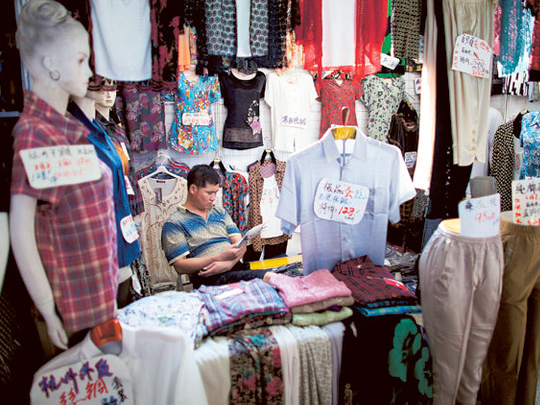
Beijing: China must step up pro-growth policies over the next three months or risk missing its annual growth target of 7.5 per cent, a senior official at a top government think-tank told Reuters.
Zheng Xinli, vice chairman of China Centre for International Economic Exchanges (CCIEE), said Beijing must boost investment growth, preferably by raising spending on the country’s high-speed rail network, to stop a slide in economic growth that has lasted for six straight quarters and is running into a seventh.
“Until now there have been no signs of a rebound in the economy. The GDP and factory output growth may slide further in the third quarter,” Zheng said in an interview.
China’s gross domestic product (GDP) grew 7.6 per cent in the June quarter from a year earlier, its slowest expansion in more than three years.
“If China’s economy does not bottom out in the third quarter, it would be hopeless to make it happen in the fourth quarter and we might miss the annual growth target of 7.5 per cent,” said Zheng, whose think-tank — like most of China’s top research institutions — is mandated to make policy recommendations direct to the top levels of government.
CCIEE operates under the auspices of China’s top economic policy body, the National Development and Reform Commission, and its chairman is former Vice Premier Zeng Peiyan.
“If China’s economy does not show signs of recovery in the third quarter, there will be employment problems, further deterioration of company profits and debt problems,” said Zheng, also a senior official on China’s parliamentary advisory body, the Chinese People’s Political Consultative Conference (CPPCC).
Beijing is determined that the Communist Party’s once-a-decade leadership transition, set for this autumn, happens against a backdrop of economic prosperity and social stability that it says its one-party rule provides.
The government has been fine-tuning economic policies to support growth since the autumn of last year, cutting interest rates twice, releasing an estimated 1.2 trillion yuan (Dh0.70 trillion) from bank reserves for new lending and fast-tracking a raft of state-backed investment projects.
Data readings at the start of the third quarter suggest those policy steps have yet to gain traction as exports stalled in July, growing just 1 percent on the year, while factory output growth was its slowest since May 2009.
Downbeat data
The downbeat figures prompted a number of investment banks to cut their 2012 economic growth forecasts for China - already on course for its slowest full-year of growth since 1999, according to the latest Reuters poll which has a consensus estimate of 8 per cent.
“Under such a difficult situation, China needs to keep a certain scale of investment to realise economic restructuring and lift the economy,” said Zheng.
He said action was needed to boost domestic consumption and stimulate private-sector investment in railways, public utilities and infrastructure construction.
China’s consumer inflation was likely to ease again in August — it has eased steadily from a three-year peak of 6.5 per cent in July 2011 and is now well below the official 4 percent target for 2012 — and signs of deflation may emerge, the official said.
Zheng’s favoured option is to boost spending on what is already the world’s largest high-speed railway network. Some 8,358 kilometres of track in operation by the end of 2010, according to China’s official Xinhua news agency.
China’s Ministry of Science and Technology says the government plans to have 16,000 kilometres of high-speed rail track laid by 2020.
Total railway infrastructure spending was about 708 billion yuan (Dh410.46 billion) in 2010.
China last month hiked its total railway spending plan for 2012 by 64 billion yuan (Dh37.10 billion) to 580 billion yuan, updating a plan published earlier in the year.
China’s Ministry of Railways — the country’s biggest issuer of debt behind the treasury — came under intense scrutiny in 2011 after two high-speed trains collided, killing 40 people and triggering a clampdown on construction of new lines.
State media reported in May of this year that China had expelled former railways minister, Liu Zhijun, from the ruling Communist Party for suspected involvement in economic crimes, the latest step in a corruption investigation into the railways.
Liu was sacked in February of last year for “serious disciplinary violations”. He had spearheaded an investment drive into the rail sector over the past decade.
“After summing up the lessons of last year’s crash, we should maintain comparatively big investment on high-speed lines,” Zheng said, adding that China needed more rail capacity to remove bottlenecks in the transport network.
He said the ministry’s ability to pay debt and make profits would be increased with more high-speed lines in operation.
The heavily-indebted Ministry of Railways lost 7 billion yuan (Dh4.06 billion) in the first quarter, local media have reported.












